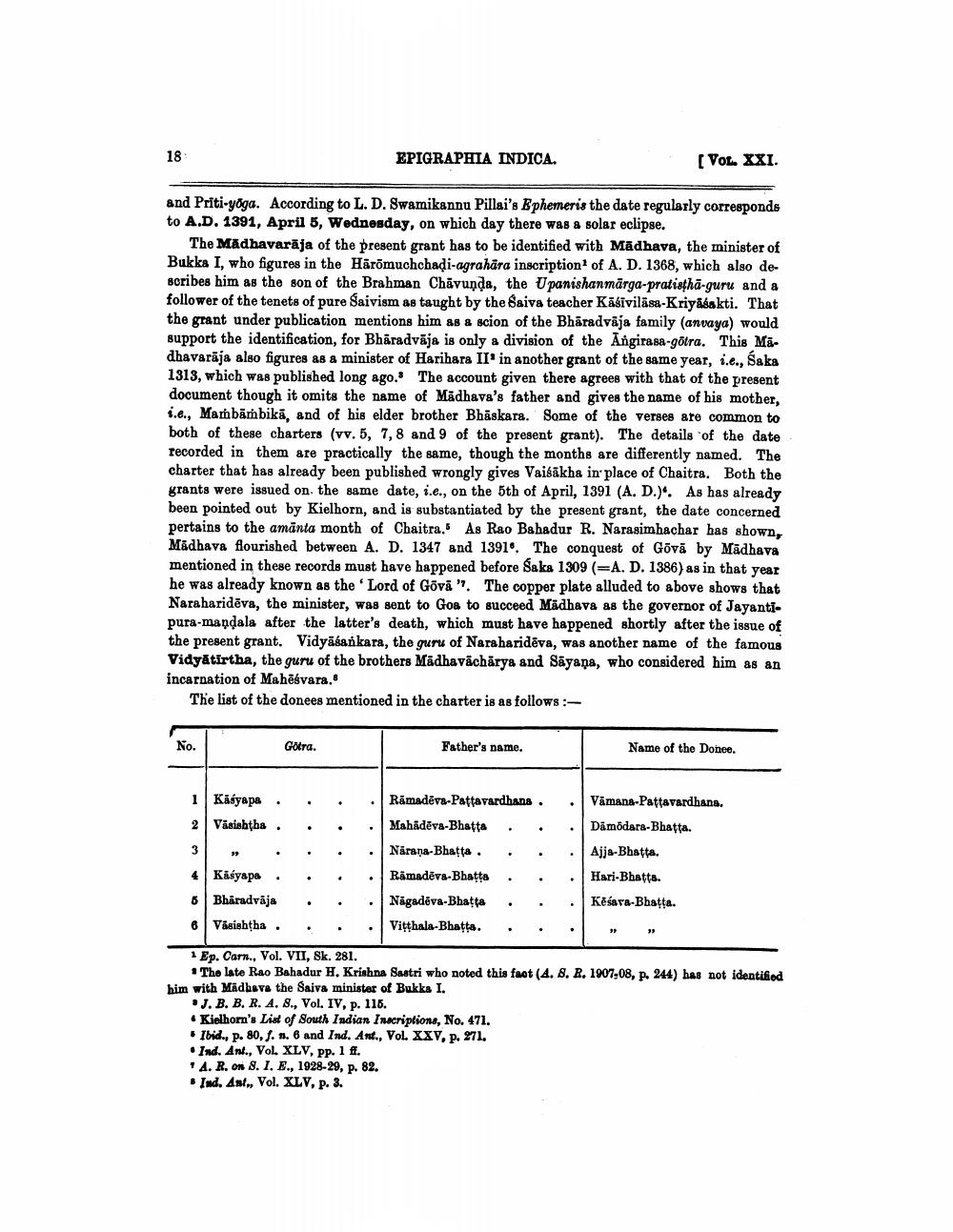________________
EPIGRAPHIA INDICA.
[VOL. XXI.
and Priti-yoga. According to L. D. Swamikannu Pillai's Ephemeris the date regularly corresponds to A.D. 1391, April 8, Wednesday, on which day there was a solar eclipse.
The Madhavarāja of the present grant has to be identified with Madhava, the minister of Bukka I, who figures in the Härömuchchadi-agrahara inscription of A. D. 1368, which also describes him as the son of the Brahman Chávunda, the Upanishanmärga-pratisthā-guru and a follower of the tenets of pure Saivism as taught by the Saiva teacher Käsivilāsa-Kriyasakti. That the grant under publication mentions him as & scion of the Bhäradvāja family (anvaya) would support the identification, for Bharadvāja is only a division of the Angirasa-gotra. This Mādhavarāja also figures as a minister of Harihara II' in another grant of the same year, i.e., Saka 1313, which was published long ago. The account given there agrees with that of the present document though it omits the name of Madhava's father and gives the name of his mother, i.e., Mambāmbikā, and of his elder brother Bhaskara. Some of the verses are common to both of these charters (vv. 5, 7,8 and 9 of the present grant). The details of the date recorded in them are practically the same, though the months are differently named. The charter that has already been published wrongly gives Vaišākha in place of Chaitra. Both the grants were issued on the same date, i.e., on the 5th of April, 1391 (A. D.). As has already been pointed out by Kielhorn, and is substantiated by the present grant, the date concerned pertains to the amanta month of Chaitra. As Rao Bahadur R. Narasimhachar has shown. Madhava flourished between A. D. 1347 and 1391°. The conquest of Gová by Madhava mentioned in these records must have happened before Saka 1309 (=A. D. 1386) as in that year he was already known as the Lord of Govā". The copper plate alluded to above shows that Nara haridēva, the minister, was sent to Goa to succeed Madhava as the governor of Jayantipura-mandala after the latter's death, which must have happened shortly after the issue of the present grant. Vidyasankara, the guru of Nara haridēva, was another name of the famous Vidyātirtha, the guru of the brothers Madhavācharys and Sayana, who considered him as an incarnation of Mahēsvara.
The list of the donees mentioned in the charter is as follows :
Götra.
Father's name.
Name of the Donee.
Kāáyapa. .
Rāmadēva-Pattavardhana . . Vāmana-Pattavardhana. Väsishtha. .
Mahādēva-Bhatta . . . Damodara-Bhatta
Närana-Bhatta . . . . Ajja-Bhatta. Käsyapa . . Ramadēva-Bhatta
Hari-Bhatta. Bharadvāj8 . . . Någadēva-Bhatta
Keśava-Bhatta. 6 Vásishtha . . . Vitthala-Bhatta. . . . 1 Ep. Carn., Vol. VII, Sk. 281.
• The late Rao Bahadur H. Krishna Sastri who noted this fact (4. 8. R. 1907,08, p. 244) has not identified him with Madhava the Saiva minister of Bukks I.
.J. B. B. R. A. 8., Vol. IV, p. 116. . Kielhorn's List of South Indian Inscriptions, No. 471.
Ibid., p. 80, . 1. 6 and Ind. Ant., Vol. XXV, p. 271.
Ind. Ant., Vol. XLV, Pp. 1 ff. * A. R. on 8. I. E., 1928-29, p. 82.
Ind. Ant., Vol. XLV, p. 3.




